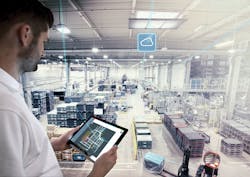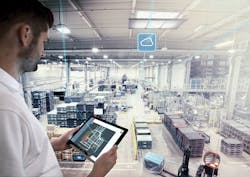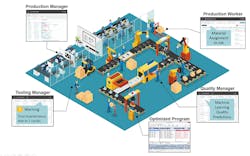By now, we’ve become accustomed to calling on Alexa to dim the lights or asking Siri for instructions on how to circumvent rush hour traffic. But what about harnessing the accessibility and built-in intelligence that virtual assistants have to offer for industrial automation applications on the plant floor?
While specific product offerings are not quite ready for prime time, the idea of virtual assistants laboring on the plant floor is gaining traction among automation vendors and industry pundits. According to Gartner, by 2022 more than half of all people collaborating in Industry 4.0 ecosystems will employ some form of virtual assistant or intelligent agent as a way to spark more natural interaction with their surroundings and colleagues. IDC is similarly bullish on the potential for virtual assistants in the enterprise: The research firm predicts that use of task-level intelligent applications to augment the human workforce will comprise nearly a third (30%) of enterprise applications by 2022. Fast forward another five years, and IDC expects advances in machine learning to enable a new generation of cognitive systems able to detect and sense their environment, learn independently, and initiate decisions or provide human workers with intelligence-based recommendations.
Fueled by the possibilities, proponents see a bright future for intelligent agent technology as a way to help shop floor and field maintenance supervisors monitor automation equipment and machinery far more effectively than traditional methods—which involves making physical rounds to disparate human-machine interface screens to check in on operations. Virtual assistants can also offer operators ease of access to critical machine status and environmental data, helping them work smarter and more efficiently. Over time, experts see virtual assistants playing an even more expansive role, from proactive alerting that can help optimize operations, prevent downtime, and ensure quality production to automating specific actions and tasks to allow plant floor personnel to focus on higher-value activities.
“The promise of virtual assistants [on the plant floor] is faster retrieval of information, which is ultimately about efficiency and productivity,” notes Steve Dertien, chief technology officer at PTC. “If you have to go to five or six screens or run back and forth across the shop floor, it’s a lot of wasted energy. You don’t want to have to run to the end of a large production machine just to access data displayed on the screen—you want to be able to ask questions and get answers.”
Ask and answer
Enterprise resource planning (ERP) provider, Epicor Software, is among the early pioneers tuning to virtual assistant technology to meet the needs of industrial applications. Currently being previewed at select customer sites is Epicor Virtual Assistant (EVA), an intelligent agent used to automate ERP processes like rescheduling manufacturing jobs or to execute simple queries—for example, getting specifics on product pricing or part quantities on hand—through natural voice and text messaging interaction. The target for virtual assistants, like EVA, is shop floor personnel who habitually roam the plant floor, monitoring and collecting information as part of their daily duties to fine-tune machinery and optimize production runs, according to Steve Coolidge, senior product manager at Epicor.
“The virtual assistant allows them to do that without having to stop and run back to the office or find a terminal on the plant floor,” Coolidge explains. “EVA allows them to have a conversation with the back-end system without impeding their job or daily work.”
What virtual assistants like EVA also do is allow the shop floor supervisor to stay informed and make smarter decisions without interrupting operators. “Typically, the supervisor is asking questions of operators running jobs, which takes the focus of the operator away from their task at hand—producing quality parts off of the equipment,” Coolidge says. “The upside of virtual assistants is they don’t have to interfere with operations people, they can ask questions about the resources they are standing in front of without any breaks or unproductive downtime.”
While EVA is currently operational primarily as a query tool, Epicor and other vendors see a natural progression for shop floor digital assistants—from asking and answering questions to receiving alerts about key milestones and bottlenecks with the eventual ability to orchestrate on-the-fly changes that will resolve specific problems. Plataine claims to be doing just that with its Total Production Optimization (TPO) suite, a cloud-based platform it bills as an intelligent automation and optimization solution for advanced manufacturing.
The nine apps in TPO leverage artificial intelligence (AI) technology to tackle specific problems manufacturers face, including material and asset tracking, tool tracking and servicing, cutting and kitting optimization, and work in progress optimization, among others, according to Plataine President and CEO Avner Ben-Bassat.
Plataine’s digital assistants collect data from sensored plant floor equipment, enterprise systems like ERP, and domain expertise from employees, then synthesize the information through context-aware AI software, and build on that intelligence to predict and resolve events before they happen, Ben-Bassat explains. “We not only tell a supervisor that this job on machine four is going to be late because of a particular bottleneck, we give them a recommendation to move the job to this specific machine using this batch of materials,” he says. “Users get constant feedback on potential problems and recommendations on what to do next.”
Plataine has also elevated the utility of its intelligent apps via a partnership with Google. Factory floor employees can now use the Google Glass wearable to communicate with Plataine’s TPO digital assistants, allowing them to receive alerts, analytics, and real-time status updates in both audible and visual formats. Plataine is also working with enterprise software vendors such as Siemens Digital Industries Software to embed the digital assistant technology into core enterprise production systems like ERP, manufacturing execution systems (MES), and product lifecycle management, he says.
Other potential applications
Many mainstay automation vendors that haven’t yet ventured into virtual assistant territory see an upside to the technology for specific use cases. Bosch Rexroth, for example, believes training and safety applications will drive the proliferation of digital assistants, noted Rodney Rusk, the company’s Industry 4.0 business leader. Consider the onboarding of a new associate on a shop floor specializing in low-volume, high-variability production who needs hands-on supervisory instruction to adequately understand the product mix. “A virtual assistant could provide work instructions and training through a combination of motion detection and other types of measurables,” for example, initiating a voice command or activating a warning light if the worker selected parts from the wrong bin, Rusk explains.
At least in the initial round of use cases, Rockwell Automation considers virtual assistants a new “automated usability” paradigm that allows industrial users to interact with existing systems and applications in different ways, according to Pradeep Kaushik, Rockwell’s manager of product management. Instead of having to toggle between multiple user interfaces and myriad screens, a shop floor user could keep tabs on equipment status, be presented with relevant data, and monitor alerts via a single interface. “You don’t need multiple touch points, which is good for users that are not experts,” Kaushik says. “You create a convergence of usability for simple tasks that are regularly done on the shop floor.” Rockwell’s FactoryTalk TeamOne mobile app would be the natural place to add virtual assistant capabilities, he says.
When you combine the usability benefits of a virtual assistant with the power of augmented reality (AR), you’re really on to a paradigm shift. Rockwell, and its strategic partner PTC, see virtual assistants as a natural complement and extension of augmented reality, which is increasingly being adopted by their shared user base. The combination of virtual assistants and AR would enable workers to go more hands-free as they go about their operations.
“Voice becomes a way to interact because use of your hands is limited,” PTC’s Dertien explains. “Plus you can’t put buttons everywhere in the AR world for every question you want to ask. That doesn’t make sense. If you’re thinking hands free, getting information anywhere, at any time via voice makes a lot of sense.”
Challenges ahead
In addition to the lack of available options, a variety of deployment challenges means plant floor virtual assistants are still a relatively nascent market. Connectivity is a major hurdle as the technology requires a healthy stream of device, status, and environmental data emanating from Industrial Internet of Things-connected machines and equipment on the shop floor. Many older manufacturing environments still lack broad connectivity—in particular, Internet of Things (IoT) capabilities on legacy equipment. “ The more data you’re getting from the shop floor and specifically, the more timely data, the better the system will be able to inform you,” says Epicor’s Coolidge. “As companies move from a traditional manual shop floor to using advanced MES and going to a fully IoT-connected factory, you are going to step up how well the virtual assistant can provide information.”
Training the virtual assistant to understand the specific requirements of an individual factory is another major hurdle. Every factory has heterogeneous equipment and different configurations, which makes it difficult to create context for the virtual assistant to provide answers. In addition, IoT technology can aggregate data from different places to answer questions like, what is the current temperature of a machine or how is a process running today, but there is still a need for capabilities at an application programming interface level to curate all that information. “That’s the billion-dollar automation question—it’s hard to have replication in a world where every factory is a snowflake in terms of machines,” PTC’s Dertien says.
Intermittent connectivity, the noise factor on the typical plant floor, and company policy towards allowing use of mobile devices in an official capacity are other factors manufacturers will need to hammer out before industrial virtual assistants become a reality. The issue of harnessing the right talent to build the virtual assistants is another tall order. To ease that process, Microsoft offers Power Virtual Agent, a low-code/no-code platform that allows the average business user to build chatbots and virtual assistant technology.
“The future demand for virtual assistants is vastly going to outstrip the number of developers that can realistically create these capabilities over the next five years,” contends Charles Lamanna, Microsoft’s corporate vice president for low-code platforms. “To truly democratize virtual assistant skills, having people who understand business processes is an essential ingredient to driving this change quickly.”





